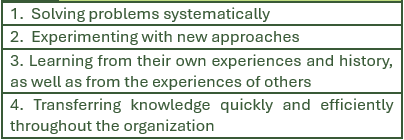[StratBus] 1 - Concepts of Business Policy
1/35
There's no tags or description
Looks like no tags are added yet.
Name | Mastery | Learn | Test | Matching | Spaced |
|---|
No study sessions yet.
36 Terms
Business Policy
This generally refers to a set of rules that guides the conduct of the business in pursuit of profit and other objectives of the business organization
Strategy
This refers to top management’s plan to attain the outcomes consistent with the organization’s mission and goals
Strategy
It is the management’s “game plan” to achieve the following:
Attract and please customers
Stake out a market position
Conduct operations, and
Compete successfully
Strategy
It forms a comprehensive master plan stating how the corporation will achieve its mission and objectives
Corporate Strategy
Overall direction in terms of its general attitude toward growth and the management of its various business and product lines
Business Strategy
Usually occurs at the business unit or product level and it emphasizes improvement of the competitive position of the corporation’s product or services in the specific industry or market segment served by that business unit
Functional Strategy
Approach taken by the functional area to achieve corporate and business unit objectives and strategies by maximizing resource productivity
Hierarchy of Strategy
It is the grouping of strategy types by level in the organization
Hierarchy of Strategy
This is a nesting of one strategy by level in the organization
Strategic Management
It is a set of managerial decisions and actions that determines the long-run performance of a corporation
Strategic Management
This emphasizes the monitoring and evaluation of external opportunities and threats considering a corporation’s strengths and weaknesses
Strategic Management
This incorporates such topics as long-range planning and strategy
Strategic Management Process

Situation Analysis
This includes environmental scanning, this is the monitoring, evaluating and disseminating of information from the external and internal environments to key people within the corporations.
SWOT Analysis
It is an acronym used to describe those particular Strengths, Weaknesses, Opportunities and Threats that are strategic factors for a specific company
External Environment
Variables that are outside the organization and not typically with the short-run control of top management
Internal Environment
Variables that are within the organization itself and are not usually within the short-run control of top management
Strategy Formulation
It is the development of long-range plans for the effective management of environmental opportunities and threats, considering corporate strengths and weaknesses
Strategy Formulation
It includes defining the corporate mission, specifying achievable objectives, developing strategies and setting policy guidelines
Operational Level
Short-term and are associated with the various operational departments of the company
Competitive Level
Related to the technique in competing in a certain industry. This strategy deals with establishing competitive strength against competitors.
Corporate Level
To be able to improve both operational and competitive strategies. these strategies are long term and are involved in providing direction for the organization
Competitive Advantage
• Looks at quality
• It is tantamount to superior quality wherein a customer would pick out a particular brand that provides excellent performance.
• It is also achieved when the company always anticipates what the customers need and want
• It responds to customers’ suggestions and attends, analyzes and monitors customer complaints
Strategy Implementation
It is the process by which strategies and policies are put into action through the development of programs, budgets and procedures.
Strategy Implementation
This process might involve changes within the overall culture, structure and/or management system of the entire organization.
Strategy Evaluation and Control
It is the process in which corporate activities and performance results are monitored so that actual performance can be compared with desired performance
Concept of Strategy

Benefits of Strategic Management
• Clearer sense of strategic vision for the firm
• Sharper focus on what is strategically important
• Improved understanding of a rapidly changing environment
Globalization
The internalization of markets and corporations has changed the way modern corporations do business
Electronic Commerce
This refers to the use of the Internet to conduct business transactions
Theories of Organizational Adaptation
Globalization and Electronic Commerce
Population Ecology
Institution Theory
Strategic Choice Perspective
Organizational Learning Theory
Population Ecology
Proposes that once an organization is successfully established in a particular environment niche, it is unable to adapt to changing conditions
Institution Theory
Proposes that organization can and do adapt to changing conditions by imitating other successful organizations
Strategic Choice Perspective
Proposing that not only do organizations adapt to a changing environment but also have the opportunity and power to reshape their environment
Organizational Learning Theory
Organizations adjust defensively to a changing environment and use knowledge offensively to improve the fit between the organization and its environment
Creating a Learning Organization
